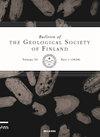芬兰南部Pyhäntaka组:在造山带内不整合上的变质砂岩和变质火山岩序列
IF 1.3
4区 地球科学
Q2 GEOLOGY
引用次数: 5
摘要
碎屑锆石研究表明,芬兰南部少数石英岩产状年龄小于1.87 Ga,表现出在斯韦芬系造山带1.89-1.87 Ga增生变形变质作用后的沉积作用。在Pyhantaka地区进行了详细的野外工作,在变质岩(堇青石双辉岩)和沙粒岩中区分了一个翻转地层。Pyhantaka组最大厚度为1000米,由石英岩上覆变质长石、变质岩和变质玄武岩组成。风化面表现为不整合面,将石英岩与下伏的元砾岩分开。Pyhantaka组内部、地层下伏和上覆的变质火山岩主要为玄武岩和玄武岩安山岩,但火山碎屑岩中的长英质火山岩和英质碎屑具有双峰亲和关系。该石英岩沉积于稳定的造山期,可能是在增生之后,但在1.83 ~ 1.80 Ga碰撞变形变质作用之前。造山期的裂谷作用和河流作用在裂谷中聚集了附近来源的可变物质,是Pyhantaka组沉积和保存的可行方案。变质火山岩的地球化学图显示出一种分散性,这种分散性最好的解释是物源非均质性和地壳污染。玄武岩虽然(可能)处于增生后的环境,但由于俯冲修饰的岩石圈地幔源,玄武岩表现出弧型特征。由于再循环作用,Pyhantaka地区的副长岩虽然代表着不同的构造背景,但在地球化学上具有相似性。仅使用元素地球化学似乎不足以区分芬兰南部斯韦芬尼期的玄武岩或灰岩的构造背景,那里的吸积和后吸积背景在很大程度上被晚期碰撞所湮没。本文章由计算机程序翻译,如有差异,请以英文原文为准。
The Pyhäntaka formation, southern Finland: a sequence of metasandstones and metavolcanic rocks upon an intra-orogenic unconformity
Detrital zircon studies suggest that the few quartzite occurrences in southern Finland are younger than 1.87 Ga and express sedimentation after 1.89–1.87 Ga accretional deformation and metamorphism in the Svecofennian orogenic belt. Detailed field work in the high-grade metamorphic Pyhantaka area allowed to distinguish an overturned formation within metagraywackes (cordierite paragneisses) and psammites. The Pyhantaka formation has a maximum thickness of 1000 meters and consists of quartzite overlain by meta-arkose, metatuff, and metabasalt on top. An uncorformity, expressed by a weathering surface, separates the quartzite from underlying metagraywacke. The metavolcanic rocks within, stratigraphically underlying and overlying the Pyhantaka formation are mostly basalts and basaltic andesites, but a felsic volcanic rock and dacitic fragments in volcaniclastic rocks imply bimodal affinity. The quartzite was deposited during a stable intra-orogenic period probably after accretion but before 1.83–1.80 Ga collisional deformation and metamorphism in the Svecofennian orogen. Rifting during the intraorogenic period and accumulation of variable material in the rift from nearby sources by fluvial processes is a viable scenario for deposition and preservation of the Pyhantaka formation. Geochemical diagrams of the metavolcanic rocks show a scatter that is best explained by source heterogeneity and crustal contamination. Despite their (likely) postaccretion setting the basaltic rocks show arc-type characteristics due to subductionmodified lithospheric mantle sources. Because of recycling, also the paragneisses in the Pyhantaka area are geochemically similar in spite that they represent different tectonic settings. The use of elemental geochemistry alone appears to be insufficient for discriminating tectonic settings of basalts or graywackes in the Svecofennian of southern Finland where accretion and post-accretion settings were largely obliterated by late collision.
求助全文
通过发布文献求助,成功后即可免费获取论文全文。
去求助
来源期刊
CiteScore
1.30
自引率
0.00%
发文量
5
审稿时长
>12 weeks
期刊介绍:
Bulletin of the Geological Society of Finland (BGSF) publishes research articles and short communications in all branches of geosciences. Contributions from outside Finland are welcome, provided that they contain material relevant to Finnish geology or are of general interest.

 求助内容:
求助内容: 应助结果提醒方式:
应助结果提醒方式:


